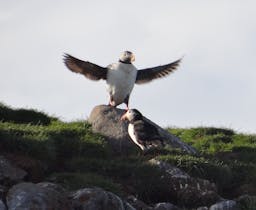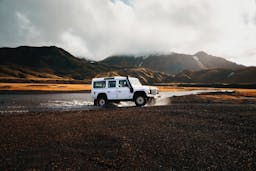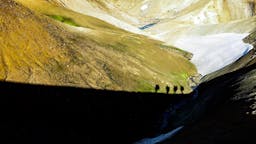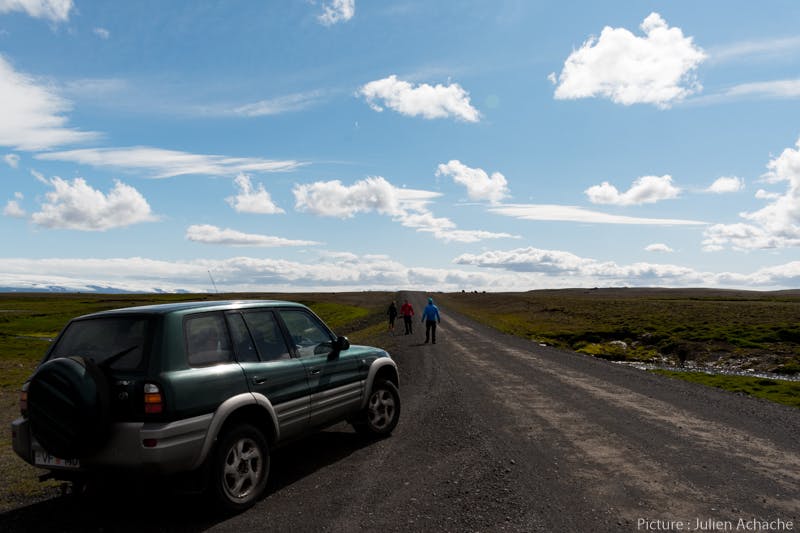
A Kjalvegur Itinerary: Hveravellir and Kerlingarfjöll
The road of Kjölur, F35 (Kjalvegur) is probably the most famous road of the Icelandic highlands. It crosses the country from north to south, and ends right by Gullfoss, which is part of the Golden Circle, and one of the most visited sites of Iceland. Driving this road is most certainly an amazing experience, but not every car can venture on it. Also, it requires planning your trip in advance. Here are a few tips to make the best of it.
Overview of the Kjölur track
I spoke in a previous article about my birthday trip on the canyon trail, a hike that goes from Ásbyrgi to Dettifoss in the Vatnajökull national park in the north of the country. Right after that hike we headed to the Kjalvegur to spend a few more days in the highlands, so yes; this was still part of my birthday vacations (yeah!).
We drove from Dettifoss to Blönduós on road number one and camped there for the night. We first aimed to sleep in Hveravellir, but a broken exhaust pipe made us sleep at Blönduós instead. If you have a choice, unlike us, I do not recommend sleeping at the Blönduós campsite. Facilities are perfectly fine but the ground is, or at least: was, terrible. The next morning our adventure on the Kjölur track began. Therefore, I will describe a trip on the Kjalvegur from Blönduós (closest town from the track F-35) to Gullfoss (most famous site after the road is paved again).
The Kjalvegur is probably one of the easiest F-roads to drive. The term F-Road is assigned to the roads of the highlands. Although, like on any F-road, you cannot drive on it without at least a regular 4 wheels drive vehicle. Some of the F-roads will even require more geared vehicles because you will encounter bigger obstacles like fords to cross, sometimes deep ones. Most of the rental car insurances do not cover damages done to the car because of rivers crossing. Please read carefully at the end of this article about the rules of driving in the Icelandic highlands.
The drive is 200 kilometers total (124 miles) and will take almost 4 hours. The route is gorgeous as it passes between two glaciers: Langjökull and Hofsjökull. On this road, you will indeed have to drive very slowly and carefully, it is narrow and packed with potholes and puddles of mud, but you will not have to cross any river. If you are not the one driving, then this slow pace will actually be a blessing, giving you all leisure to stare at the amazing deserted highlands by your window. A few rest points with beautiful panoramas are available among the road, so refrain from any wishes to stop at random places on the road or on the side.
From Blönduós to Hveravellir
From the Ring Road, you will not have to drive long before starting to venture on The Kjalvegur. Once on it, first thing to hit you is a feeling. The feeling of being completely alone and far away from any sign of civilization. Of course it is fake sensation as the town you just left is roughly 50 kilometers (30 miles) behind. But except for a few sheep, you will not notice any living being, kilometers away. Maybe you will spot another car driving the other way, but even this, is quite unlikely.
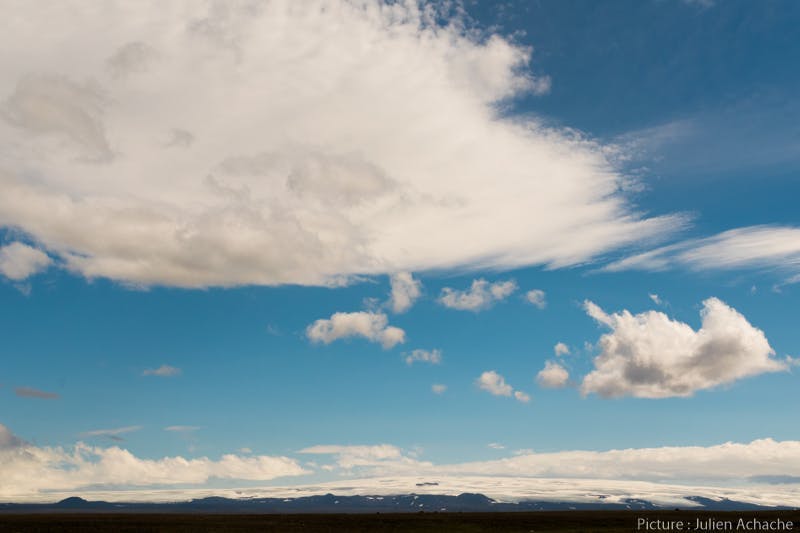 So, you are driving and your lucky passengers are enjoying the view through their windows, in the pleasant and comfy warmth of the car. But you have to keep your eyes on the road, no matter what. And, as they keep yelling: “look here” and “Oh! Have you seen that?” you get slightly annoyed, a bit jealous, but you know you cannot blame them. Landscapes are simply gorgeous around you. So you have two options, and I tried both. First, you blind your passengers. For this, you just have to drive right through the puddles of mud; it will splash the windows, no way to see through them now. Fortunately, windshields have wipers. I do not recommend this option because it turned out that … passengers are more annoying and noisier when they are angry and frustrated. Also, you still do not get a chance to enjoy the landscapes yourself.
So, you are driving and your lucky passengers are enjoying the view through their windows, in the pleasant and comfy warmth of the car. But you have to keep your eyes on the road, no matter what. And, as they keep yelling: “look here” and “Oh! Have you seen that?” you get slightly annoyed, a bit jealous, but you know you cannot blame them. Landscapes are simply gorgeous around you. So you have two options, and I tried both. First, you blind your passengers. For this, you just have to drive right through the puddles of mud; it will splash the windows, no way to see through them now. Fortunately, windshields have wipers. I do not recommend this option because it turned out that … passengers are more annoying and noisier when they are angry and frustrated. Also, you still do not get a chance to enjoy the landscapes yourself.
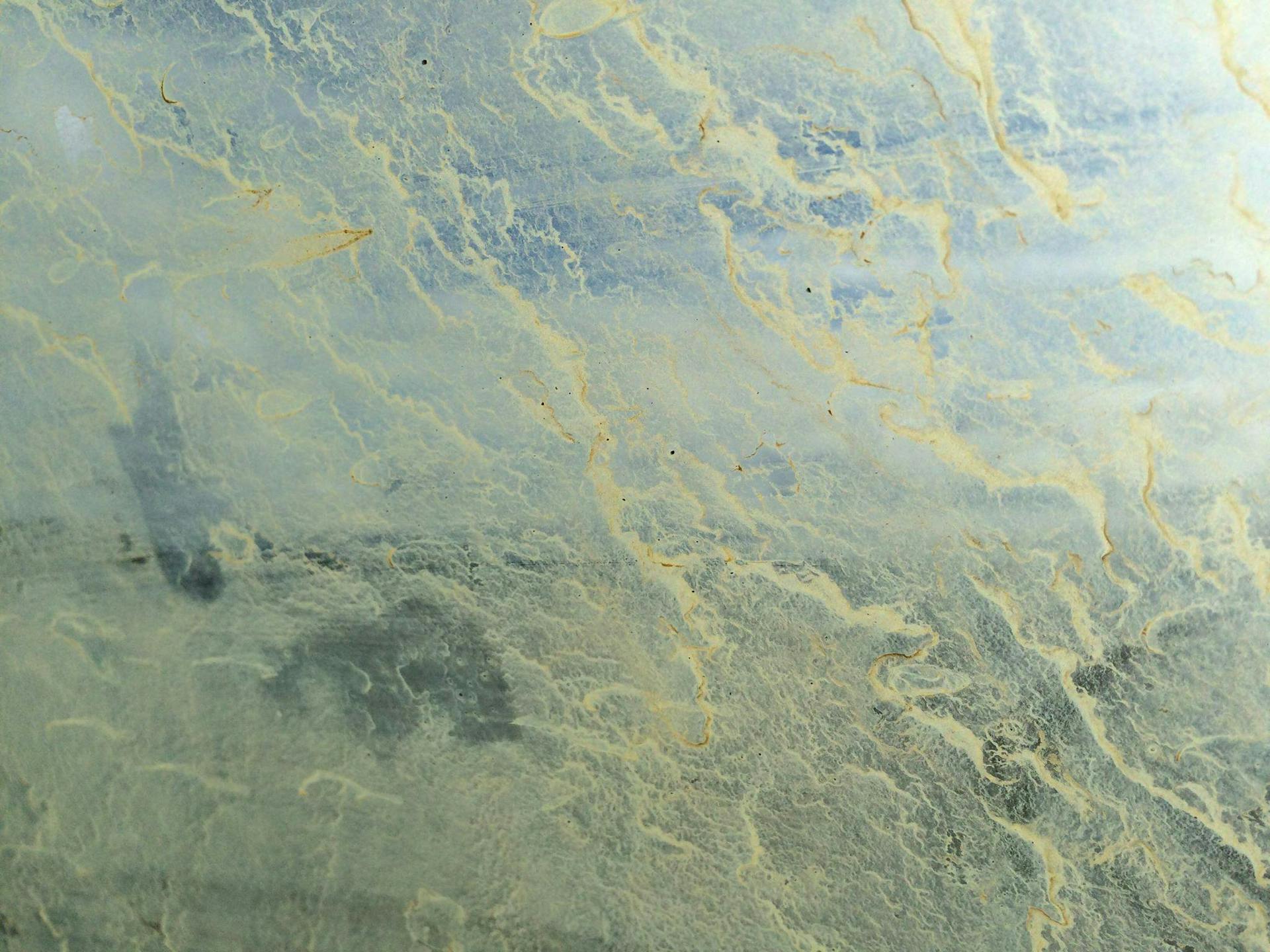
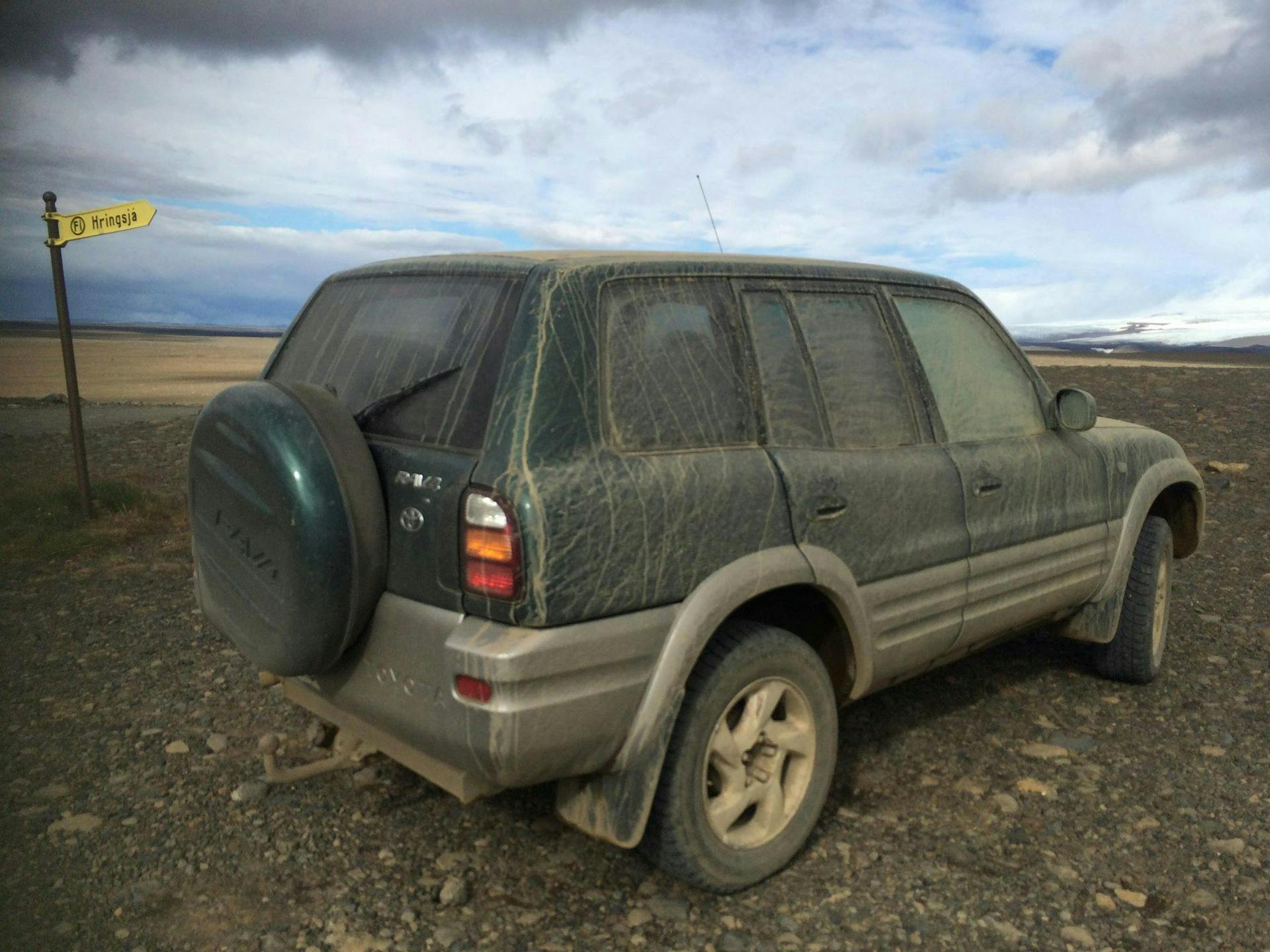
So second option, definitely the best for everyone: have a quick stop every single time you get the opportunity. As mentioned, there are plenty of places designated for quick rests and taking beautiful pictures. The road is a part of the trip, you must make the best of it and enjoy it as well.
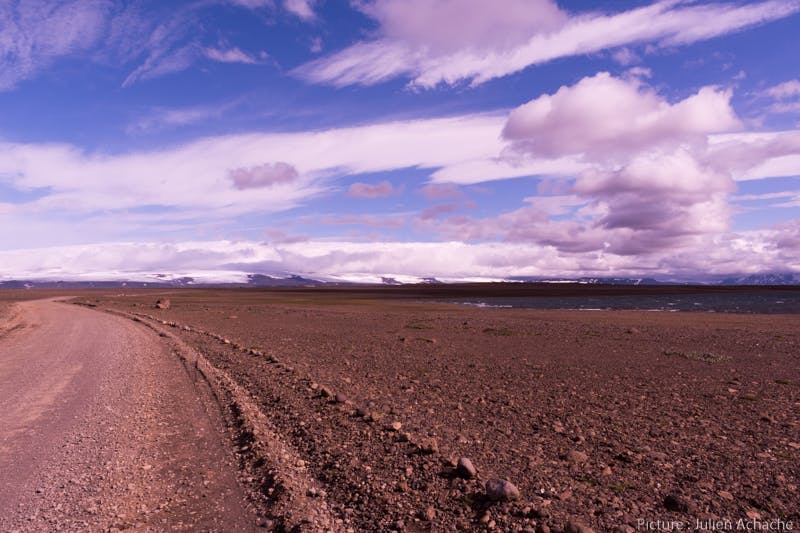 After 109 km (68 miles) and almost two hours driving, you arrive at Hveravellir. Hveravellir is definitely the first highlight of The Kjalvegur. It is a geothermal area perfectly located in the middle of nowhere. One can spend either a few hours or a few days there. It is packed with hiking paths and you will have all the necessary facilities whether you plan to camp or sleep in a proper bed. You will find more technical information about accommodation at the end of this post. There, one can enjoy day hikes, take a dip in a natural pool or just grab a coffee on a sunny terrace and gaze at the surroundings.
After 109 km (68 miles) and almost two hours driving, you arrive at Hveravellir. Hveravellir is definitely the first highlight of The Kjalvegur. It is a geothermal area perfectly located in the middle of nowhere. One can spend either a few hours or a few days there. It is packed with hiking paths and you will have all the necessary facilities whether you plan to camp or sleep in a proper bed. You will find more technical information about accommodation at the end of this post. There, one can enjoy day hikes, take a dip in a natural pool or just grab a coffee on a sunny terrace and gaze at the surroundings.
Iceland is a volcanic island, therefore, all across the country; you will find geothermal areas, each one with its own specificity. Hveravellir is rather flat, from there, you can actually spot some mountains, but all of them are pretty far away. Landscape when you get there is quite unreal, the ground has been melted by the geothermal activity, the place is scattered with bubbling holes and fumaroles, the air smells like sulfur and despite being in the Icelandic highlands, Hveravellir is quite warm (relatively).
Let’s consider two scenarios: First, a quick stop, just a few hours (what we actually did), then, a 24 hour stop including an overnight stay.
A few hours in Hveravellir: The Green Trail
For this scenario, I will basically just describe what we did there. We arrived at Hveravellir a bit after noon. We had quite a decent and late breakfast so we did not feel the urge to try the restaurant, although I had a quick glance at it and it looked cozy and nice. The weather was awesome, a typical summer’s day, just a few clouds, a bit windy, and relatively warm. As mentioned before, our previous night was not the best and the morning was quite long as we had to wait for the car’s exhaust pipe to be fixed. This is why first thing we did was to take a nice and long bath in the natural hot pool.
One of the best thing about geothermal areas is that most of them come with a pool of naturally hot water. Actually, water is often too hot and cooled down artificially so you can dip in. What I mean by artificially is simply that boiling hot water and cold water come from two different pipes and get mixed in the hole you are dipping in. Cold and hot water are both coming from natural springs. When the hole overflows, water just flows back to nature. This is why one must always wash himself before entering those pools. There are no chemicals or filters in the water.
Hveravellir is like an oasis in the highlands. While driving on the Kjölur track, the highlands will seem completely deserted. You might spot a sheep here and there, but one will wonder how they can actually manage to feed themselves. Thanks to the geothermal activity and the presence of water, Hveravellir is actually quite green, there are much more sheep, and it is quite understandable how life can exist in here. Fun fact about this place is that some of the most notorious outlaws of the country hid there for twenty years, the area provided enough warmth to survive during winters. The hot water flows all year long and can be used for many purposes including cooking. They were named Fjalla-Eyvindur and Halla Jónsdóttir and their story took place circa 1760. If you want to know more about life in the highlands, I wrote about it in a previous article, telling about the life of a farmer’s family in Svinadalur.
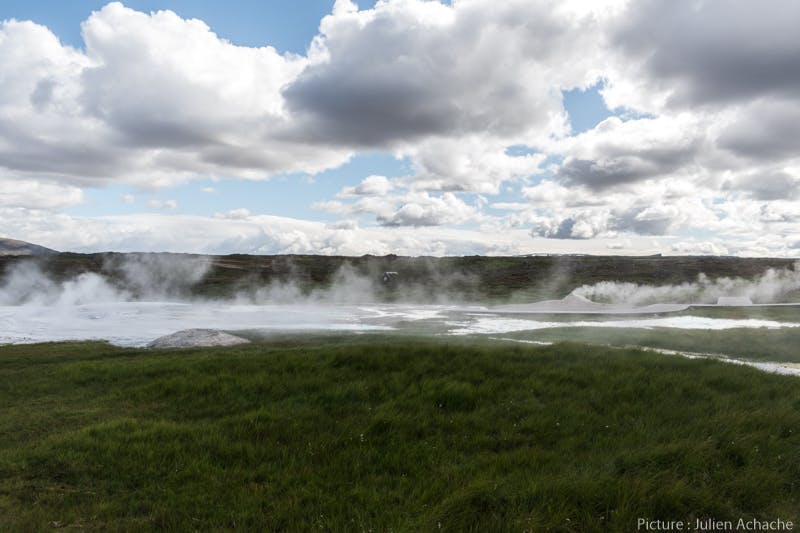 After we got out of the pool, we decided to take a quick walk around the place. Among the three main hiking trails, there is one that will just take you thirty to forty minutes. There is no elevation and it is marked as The Green Trail. You do not need hiking boots to walk it. First, it will take you around the hot springs and fumaroles on a man-made wooden path. You will then walk on a path of dirt and pass before the former shelter of the outlaws Fjalla-Eyvindur and Halla Jónsdóttir.
After we got out of the pool, we decided to take a quick walk around the place. Among the three main hiking trails, there is one that will just take you thirty to forty minutes. There is no elevation and it is marked as The Green Trail. You do not need hiking boots to walk it. First, it will take you around the hot springs and fumaroles on a man-made wooden path. You will then walk on a path of dirt and pass before the former shelter of the outlaws Fjalla-Eyvindur and Halla Jónsdóttir.
Half way through your walk, there is a volcanic formation; it looks like earth made a bubble that froze in time. There is actually a small path on this huge and isolated bump, I recommend you to take it as it will grant you with a 360° view on your surroundings. With two glaciers around you, it will be a shame not to take the opportunity. The whole trail is a loop, so you will come back to your starting point. From there, you can either have a meal at the visitor center or head to your next destination.
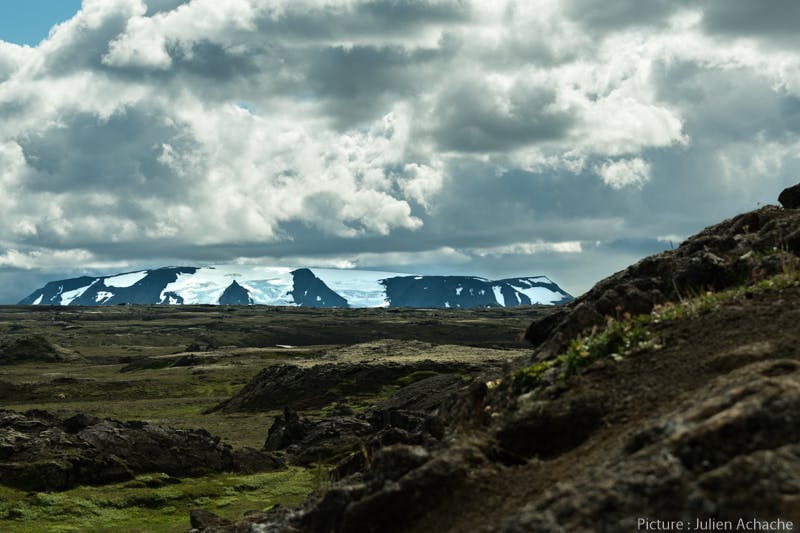
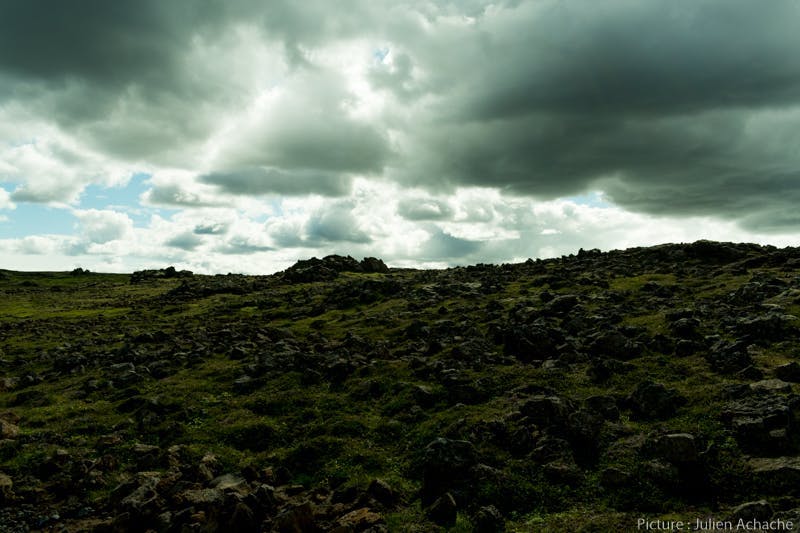
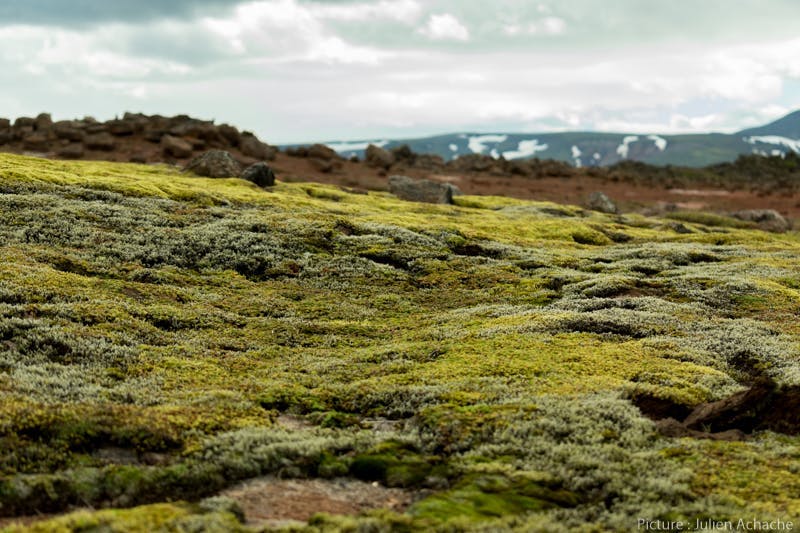
One full day in Hveravellir: The Orange Trail and The Red Trail
Let’s now picture the following scenario: you are an early bird, you arrive in Hveravellir quite early, it is peaceful and quiet. Herds of visitors have not gotten here yet, so naturally, you are tempted to take a dip and enjoy the hot pool all by yourself. This is actually a great idea and a wonderful way to start the day. One could argue that it is better to go hiking first, and then take a dip in the pool, though. Well, why not both?
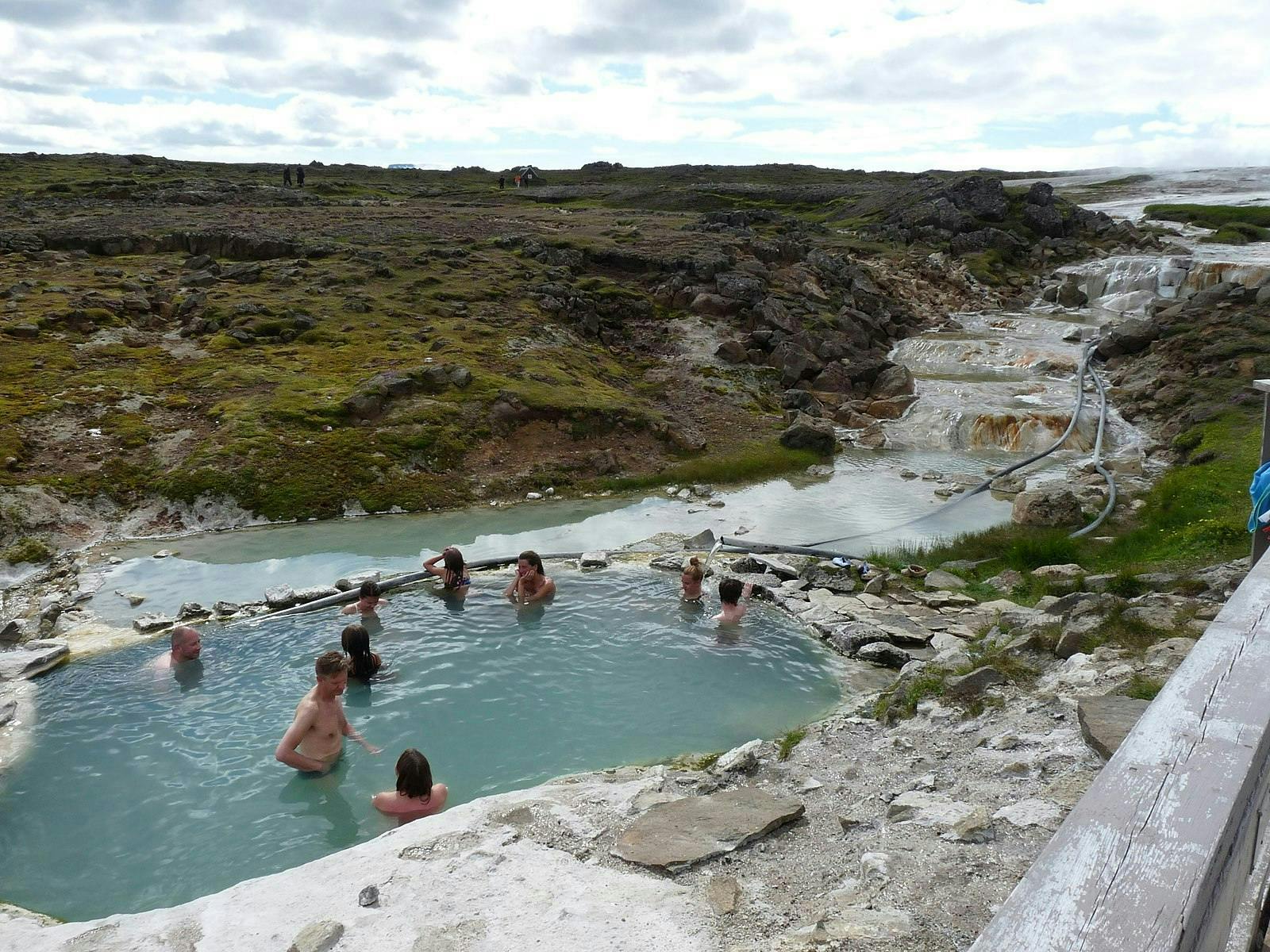 Photo: WikimediaCommons.
Photo: WikimediaCommons.
You are now out of the bath, dry and relaxed, and ready to hike. One might want a hot coffee before venturing in the wilderness. That is fair enough, and the visitor center also has a cafeteria-restaurant with a lovely terrace is the weather is sunny enough.
For a longer hike than the walk mentioned above, you have two options. I did not personally walk any of those, so my description comes from information I got on the spot and additional knowledge I have gotten online (mostly to refresh my memory). One of the hikes, The Red Trail, is doable in 3 to 4 hours and the second, The Orange Trail, takes between 4 and 5 hours. The most enthusiastic hikers can do both in one day
The Red trail is 12 km, roughly 7.5 miles, and elevation is 240 meters, around 780 feet. You might have a few tiny streams to cross, but nothing spectacular. it does not require you to be in an especially good physical condition or to have specific hiking gear. Hiking boots and warm clothes should be enough. Landscapes will mostly consist of a volcanic desert; one can expect brown and dark colors all over the place. The highlight of the hike is when you will reach the crater of Styrtur, which erupted 7000 years ago. If you’d like to walk around it, it is doable, and will only require you to walk 2 additional kilometers. If the weather is clear enough, you will see the two glaciers, Langjökull and Hofsjökull before the horizon.
The Orange Trail is 21 km, so approximately 13 miles, and the highest point of the walk is around 145 meters high, which roughly equals 475 feet. From what I heard, this trail might the most spectacular of the area. Like The Red Trail, no need for you to be an athlete or a very experienced hiker to walk it. You will evolve through Þjófadalir, meaning “the thieves’ valley”, it is, of course, related to the story of the outlaws mentioned above. Here one can expect to see more vegetation than on The Red Trail and even find some berries. Also, here is a little tip: bring a bottle with you; you will encounter a stream of crystal clear water originating from the glacier nearby. It is perfectly safe to drink, and even recommended.
After your walk(s), you can of course bathe yourself in the hot water to relax those sore muscles, then have dinner at the restaurant. To stay for the night, you can choose between camping or proper room, to have more information about accommodation, have a look at the end of this article.
Hveravellir offer many options, and can be visited for all kind of purposes. You can just have a quick glance at the fumaroles and those unique geothermal formations, always giving you the option to bathe into natural hot water. Or, you can go for a walk, with many choices of length. If you click this link, you can have a look at the tours that we offer at Wonderguide.
Back on Kjölur, Next stop: Kerlingarfjöll
I described earlier the incredible beauty of the road, be sure it goes on after you passed Hveravellir. The only thing one should know is that it becomes harder to drive after that, with a lot more potholes
As most of the travelers on the Kjalvegur, you will probably want to stop in Kerlingarfjöll. This is also a geothermal area, and a pure paradise for hikers. It was the first time I went there and I felt like I was on another planet. This is definitely one of my favorite places in Iceland. Maybe even my favorite. I will not describe it much more as we already have a very well written article about Kerlingarfjöll. I will still provide the most basic information. One must know that the facilities there are amazingly cozy, there is also a natural hot pool, you have dozens of hikes doable in a few hours and also one that will take you between 2 and 3 days. I will not write more about it, but here is a picture:
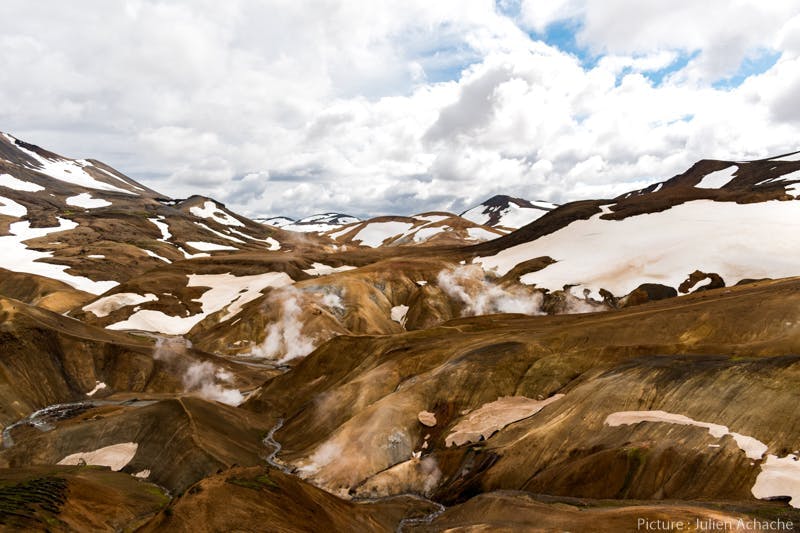 On your way back to Reykjavík (if it is your next destination) you will pass before the main sites of the Golden Circle: Gullfoss, Geysir and þingvellir. If you have not visited them yet, take the opportunity to have a quick glance. We also sell a variety of Golden Circle tours.
On your way back to Reykjavík (if it is your next destination) you will pass before the main sites of the Golden Circle: Gullfoss, Geysir and þingvellir. If you have not visited them yet, take the opportunity to have a quick glance. We also sell a variety of Golden Circle tours.
Practical information
This sounds amazing, but can I go there in winter?
Basically, no, you cannot go there except in summertime. F-Roads are only open roughly from mid-June to mid-September, and often shorter than that. Before you venture into the Highlands, you must always check your itinerary on those two websites: Safetravel.is and Road.is. Checking the websites is important, following and respecting their warnings is crucial.
Is it that hard to drive on the Track of Kjölur?
No it is not that hard, as mentioned, there are no rivers to cross. Although, one must absolutely have those rules in mind for safe and nature friendly trip:
• You must drive a four-wheel drive vehicle.
• Most of the car rental companies do not allow anyone to drive in the Highlands, check with them prior traveling. If they do not allow it, do not do it.
• Off-road driving is strictly prohibited, and for very good reasons. If you go off-road and get caught you will be likely to be fined for a thousand dollars at least, probably more.
What exactly means “off-road driving”?
This one might sound obvious, even ridiculously obvious. But too much precision is better than none. “Off-road driving”, means “driving off the road” whatever the situation is. If there is an obstacle on the road that blocks the way, you are not allowed to drive off the road to go around it. Your options are to move it if you can, otherwise, go back where you came from. If there is a river that is too deep for you to cross it, you must not venture further to see if there is an easier way. And so on. Basically, if your tires get off the road even from a meter, this is a technically a criminal offense.
Why is it so strict? Because the marks left by a vehicle in the fragile nature of Iceland, especially in the highlands, will take decades to disappear. Remember when you were driving and enjoying this untouched nature? It is your responsibility to leave it untouched so other people can enjoy it as well
Click here to know everything about driving in Iceland and in the Highlands
What are the options regarding accommodation in Hveravellir?
If you want a proper bed, there are two options, one option is “The New Hut”, where private rooms can host up to 3 people, beds are made up and breakfast is included. If you rent one of those rooms, you will also be entitled to use the shared showers facility, and of course the hot pool. Those rooms costs 28,800 ISK per room
The other option is "The Old Hut". The Old Hut has 3 dormitories where one is supposed to use one’s own sleeping bag. If you do not have one, you can still ask for your bed to be made for an extra 2,000 ISK. If you are sleeping in one of the dorms (eight, ten or twelve people), breakfast is not included (1,800 ISK extra). Access to shared showers, natural pool and shared kitchen is included in the price. A bed in a dorm costs 2,000 ISK per bed.
If you are planning to choose any of those two options, it is highly recommended to book in advance
Your last option is the campsite. For 1,900 ISK per person per night, you will have access to the shared bathrooms, and the hot pool. Of course, you must have all of your camping gears with you
If you are just passing by and do not plan to stay overnight, all the facilities (toilets, showers etc.) require an individual fee that must be paid at the reception. The same rule applies in Kerlingarfjöll (information below)
What are the accommodation options in Kerlingarfjöll?
They are kind of the same as in Hveravellir, you can have a night in a dorm, in a private room, or at the campsite. For the campsite, the place is equipped with shared kitchen and shared bathrooms. I must say that everything is really cozy and I was surprised by the quality of the facilities for such a remote area. Of course, it has a cost and one must be ready to spend 2,500 ISK per person to sleep under a tent. Click on the following link to know more about accommodation in Kerlingarfjöll.
Sharing is caring!
